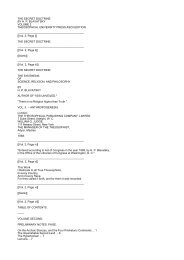You also want an ePaper? Increase the reach of your titles
YUMPU automatically turns print PDFs into web optimized ePapers that Google loves.
The Versions Of The <strong>Book</strong> Of The <strong>Dead</strong>.<br />
rubbish on <strong>the</strong> top <strong>of</strong> <strong>the</strong> same; and from <strong>the</strong> circumstance <strong>of</strong> <strong>the</strong> bones and part <strong>of</strong> <strong>the</strong> c<strong>of</strong>fin being all found toge<strong>the</strong>r, it<br />
appeared as if <strong>the</strong> c<strong>of</strong>fin had been brought to that spot and <strong>the</strong>re unpacked.--H. Raven." Vyse, Pyramids, vol. ii., p. 86.<br />
2. They are exhibited in <strong>the</strong> First Egyptian Room, Case A, and <strong>the</strong> fragments <strong>of</strong> <strong>the</strong> c<strong>of</strong>fin in Wall Case No. 1 (No. 6647)<br />
in <strong>the</strong> same room.<br />
3. See Lepsius, Auswahl, Taf. 7.<br />
4. Or suten bat; see Se<strong>the</strong>, Aeg. Zeitschrift, Bd. XXVIII., p. 125; and Bd. XXX, p. 113; Max Müller, Aeg. Zeitschrift, Bd.<br />
XXX., p. 56; Renouf, Proc. Son Bibl. Arch., 1893, pp. 219, 220; and Lefébure, Aeg. Zeitschrift, Bd. XXXI., p. 114 ff.<br />
5. It seems that we should read this god's name Keb (see Lefébure, Aeg. Zeitschrift, Bd. XXXI., p. 12 5); for <strong>the</strong> sake <strong>of</strong><br />
uniformity <strong>the</strong> old name is here retained.]<br />
{p. xxi}<br />
em ren-s en seta pet ertat-nes un-k em neter<br />
in her name <strong>of</strong> "mystery <strong>of</strong> heaven," she granteth that thou mayest exist as a god<br />
an xeft-k suten net Men-kau-Ra anx t'etta<br />
without thy foes, O King <strong>of</strong> <strong>the</strong> North and South, Men-kau-Ra, living for ever!<br />
Now it is to be noted that <strong>the</strong> passage, "Thy mo<strong>the</strong>r Nut spreadeth herself over <strong>the</strong>e in her name <strong>of</strong><br />
'Mystery <strong>of</strong> Heaven,' she granteth that thou mayest be without enemies," occurs in <strong>the</strong> texts which are<br />
inscribed upon <strong>the</strong> pyramids built by <strong>the</strong> kings <strong>of</strong> <strong>the</strong> VIth dynasty,[1] and thus we have evidence <strong>of</strong> <strong>the</strong><br />
use <strong>of</strong> <strong>the</strong> same version <strong>of</strong> one religious text both in <strong>the</strong> IVth and in <strong>the</strong> VIth dynasties.[2]<br />
Even if we were to admit that <strong>the</strong> c<strong>of</strong>fin is a forgery <strong>of</strong> <strong>the</strong> XXVIth dynasty, and that <strong>the</strong> inscription upon<br />
it was taken from an edition <strong>of</strong> <strong>the</strong> text <strong>of</strong> <strong>the</strong> <strong>Book</strong> <strong>of</strong> <strong>the</strong> <strong>Dead</strong>, still <strong>the</strong> value <strong>of</strong> <strong>the</strong> monument as an<br />
evidence <strong>of</strong> <strong>the</strong> antiquity <strong>of</strong> <strong>the</strong> <strong>Book</strong> <strong>of</strong> <strong>the</strong> <strong>Dead</strong> is scarcely impaired, for those who added <strong>the</strong><br />
inscription would certainly have chosen it from a text <strong>of</strong> <strong>the</strong> time <strong>of</strong> Mycerinus.<br />
The <strong>Book</strong> <strong>of</strong> <strong>the</strong> <strong>Dead</strong> in <strong>the</strong> Vth dynasty.<br />
In <strong>the</strong> Vth dynasty we have--in an increased number <strong>of</strong> mastabas and o<strong>the</strong>r monuments--evidence <strong>of</strong> <strong>the</strong><br />
extension <strong>of</strong> religious ceremonials, including <strong>the</strong><br />
[1. See <strong>the</strong> texts <strong>of</strong> Teta and Pepi I. in Maspero, Recueil de Travaux, t. V., pp. 20, 38 (ll. 175, 279), and pp. 165, T73 (ll.<br />
60, 103), etc.<br />
2. So far back as 1883, M. Maspero, in lamenting (Guide du Visiteur de Boulaq, p. 310) <strong>the</strong> fact that <strong>the</strong> Bûlâq Museum<br />
possessed only portions <strong>of</strong> wooden c<strong>of</strong>fins <strong>of</strong> <strong>the</strong> Ancient Empire and no complete example, noticed that <strong>the</strong> c<strong>of</strong>fin <strong>of</strong><br />
Mycerinus, preserved in <strong>the</strong> British Museum, had been declared by certain Egyptologists to be a "restoration" <strong>of</strong> <strong>the</strong><br />
XXVIth dynasty, ra<strong>the</strong>r than <strong>the</strong> work <strong>of</strong> <strong>the</strong> IVth dynasty, in accordance with <strong>the</strong> inscription upon it; but like Dr. Birch he<br />
was <strong>of</strong> opinion that <strong>the</strong> c<strong>of</strong>fin certainly belonged to <strong>the</strong> IVth dynasty, and adduced in support <strong>of</strong> his views <strong>the</strong> fact <strong>of</strong> <strong>the</strong><br />
existence <strong>of</strong> portions <strong>of</strong> a similar c<strong>of</strong>fin <strong>of</strong> Seker-em-sa-f, a king <strong>of</strong> <strong>the</strong> VIth dynasty. Recently, however, an attempt has<br />
again been made (Aeg. Zeitschrift, Bd. XXX., p. 94 ff.) to prove by <strong>the</strong> agreement <strong>of</strong> <strong>the</strong> variants in <strong>the</strong> text on <strong>the</strong> c<strong>of</strong>fin<br />
<strong>of</strong> Mycerinus with those <strong>of</strong> texts <strong>of</strong> <strong>the</strong> XXVIth dynasty, that <strong>the</strong> Mycerinus text is <strong>of</strong> this late period, or at all events not<br />
earlier than <strong>the</strong> time <strong>of</strong> Psammetichus. But it is admitted on all hands that in <strong>the</strong> XXVIth dynasty <strong>the</strong> Egyptians<br />
resuscitated texts <strong>of</strong> <strong>the</strong> first dynasties <strong>of</strong> <strong>the</strong> Early Empire, and that <strong>the</strong>y copied <strong>the</strong> arts and literature <strong>of</strong> that period as far<br />
as possible, and, this being so, <strong>the</strong> texts on <strong>the</strong> monuments which have been made <strong>the</strong> standard <strong>of</strong> comparison for that on<br />
<strong>the</strong> c<strong>of</strong>fin <strong>of</strong> Mycerinus may be <strong>the</strong>mselves at fault in <strong>the</strong>ir variants. If <strong>the</strong> text on <strong>the</strong> cover could be proved to differ as<br />
much from an undisputed IVth dynasty text as it does from those even <strong>of</strong> <strong>the</strong> VIth dynasty, <strong>the</strong> philological argument<br />
might have some weight; but even this would not get rid <strong>of</strong> <strong>the</strong> fact that <strong>the</strong> cover itself is a genuine relic <strong>of</strong> <strong>the</strong> IVth<br />
http://www.sacred-texts.com/egy/ebod/ebod03.htm (10 <strong>of</strong> 36) [8/10/2001 11:22:54 AM]

















